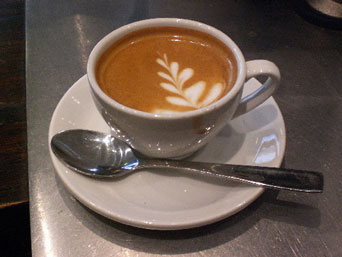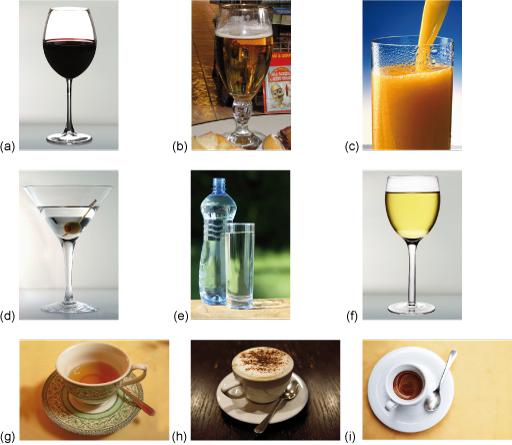1 Learning the names of drinks in Italian
In this section you find out what some common drinks and snacks are called in Italian, and hear a waiter taking an order from a group of customers.
Activity 1
Look at this list of drinks and match each drink with its corresponding picture, as in the example. Start with the ones you are already familiar with and try to guess the ones you don’t know.
Example 1 un cappuccino – h
1. un cappuccino
2. un’acqua minerale
3. una birra
4. un caffè
5. un succo di frutta
6. un bicchiere di vino bianco
7. un aperitivo
8. un tè
9. un bicchiere di vino rosso
Answer
1 – h; 2 – e; 3 – b; 4 – i; 5 – c; 6 – f; 7 – d; 8 – g; 9 – a
Activity 2
Now listen to the audio track and repeat aloud the names of the drinks you hear. Try to copy the pronunciation and intonation of the speaker as closely as possible.
Transcript
Transcript
Listen and repeat these words for different drinks, trying to match the pronunciation and intonation of the speaker.
un succo di frutta
un’acqua minerale
una birra
un caffè
un cappuccino
un bicchiere di vino bianco
un aperitivo
un tè
un bicchiere di vino rosso
Culture: Coffee drinking in Italy
You may find coffee-drinking traditions in Italy different from those in the UK or in your own culture. If you ask for un caffè, you will be served an espresso coffee. A caffè ristretto is an espresso which is even more concentrated than usual. An espresso with a tiny amount of milk is a macchiato, sometimes described as a macchiato caldo (if the milk is hot) or a macchiato freddo (if the milk is cold). You might like to try a caffè corretto, a coffee with a drop of a spirit or liqueur such as grappa in it. For Italians un cappuccino is a morning drink only, never taken after a meal. If you want a long coffee, you should ask for un caffè americano. Another milky but not so frothy coffee is un caffelatte, which is sometimes served in hotels at breakfast. Such is the importance of coffee in Italian life that some customers pay for two coffees, one to drink themselves and one paid for in advance as a charitable act for anyone in need who might drop in in the hope of a free coffee – the so-called caffè sospeso.


